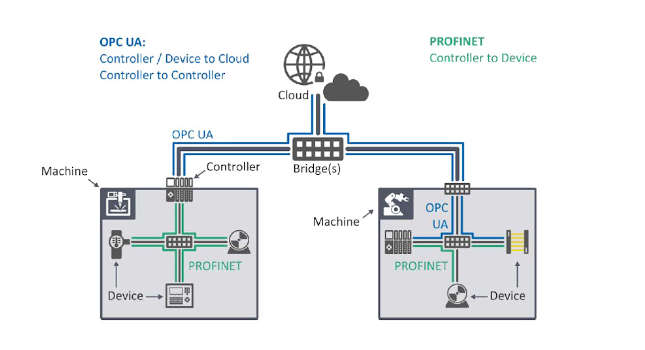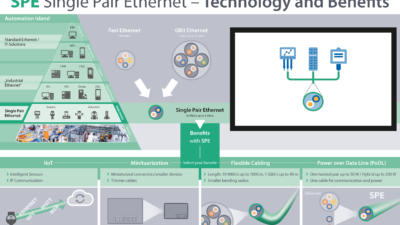Time-sensitive networking (TSN) is designed to make Ethernet deterministic by design and improve synchronicity and overall communication among devices.

Learning Objectives
- Time-sensitive networking (TSN) is designed to make Ethernet more deterministic.
- Profinet over TSN is designed for controller to device communication.
- Industrial trends such as Industry 4.0 and the Industrial Internet of Things (IIoT) lead to an increase in network traffic in ever-growing converged networks.
Ethernet standards have been evolving over years. In the 1970s, the first versions of Ethernet achieved speeds of only 10 Mbps. Then, Fast Ethernet became available in 1995 with speeds of 100 Mbps. Nowadays, gigabit Ethernet is available. Also, as Ethernet has become ubiquitous in most industries, Ethernet components have become more affordable and easier to implement. Finally, most network protocols support Ethernet as its communication medium. Therefore, Ethernet networks can employ a wide variety of protocols to fulfill applications.
Even though Ethernet speeds have been improving over the years, there is another key performance factor: Determinism. A deterministic network exchanges data in a precise manner with a defined latency. Since Ethernet communication is based on the best effort principle, data exchange in Ethernet networks lacks determinism. Until now, deterministic data exchange in Ethernet is only possible with proprietary solutions, but time-sensitive networking (TSN) aims to change that. TSN’s focus is making Ethernet deterministic by design.
What is TSN?
TSN refers to a set of IEEE 802 standards that make Ethernet deterministic by default. TSN sits on Layer 2 of the ISO/OSI Model and adds definitions to guarantee determinism and throughput in Ethernet networks. The following are some of the IEEE standards that make up TSN:
- Enhanced synchronization behavior (IEEE 802.1AS)
- Suspending (preemption) of long frames (IEEE 802.1-2018)
- Enhancements for scheduled traffic (IEEE 802.1Q-2018)
- Path control and bandwidth reservation (IEEE 802.1Q-2018)
- Seamless redundancy (IEEE 802.1CB)
- Stream reservation (IEEE 802.1Q-2018).
TSN evolved from the industry’s use of audio/video delivery and the need for more devices and synchronized communications. There are more devices on networks than ever before and more information is being shared and analyzed.
TSN for industrial automation
Many industries require deterministic Ethernet, and industrial automation is one of them. The automation industry has continuously sought solutions to achieve fast, deterministic, and robust communication. Currently, several specialized solutions are available for this purpose, such as Profinet IRT, Sercos III, and Varan. TSN can help standardize real-time Ethernet across the industry.
Industrial trends such as Industry 4.0 and the Industrial Internet of Things (IIoT) lead to an increase in network traffic in ever-growing converged networks. Such networks require flexibility and scalability to support small devices as well as big data server systems while ensuring bounded latency for time-critical communication. TSN intends to cover all these requirements. It will provide standardized mechanisms for the concurrent use of deterministic and non-deterministic communication.
TSN in Profinet networks
Profinet over TSN comes with benefits for convergence, scalability and flexibility. Users also will continue to have access to all existing Profinet features and profiles. TSN applies standardized traffic shaping tools to ensure low latency and deterministic data exchange where necessary.
Existing non-TSN Profinet devices may be used in cooperation with new TSN-based Profinet V2.4 hardware, although they might not benefit from TSN. Increased robustness is given by the underlying TSN mechanisms which protect real-time critical data against best-effort traffic. Looking at the increasing demand for data volume, which has to be transferred in parallel to time-critical data through the network in future Industry 4.0 scenarios, protecting real-time critical data is an essential feature.
Profinet over TSN is designed for controller to device communication. It can handle up to 1024 devices and achieve cycle times of 31.25 μs. OPC UA may also make use of current and future TSN standards. PI, however, is committed to applying OPC UA for controller to controller or controller/device to cloud communication. The featured diagram illustrates an example of the complementary and harmonized interplay of Profinet over TSN and IP-based protocols. Within process automation, factory automation, and motion control, Profinet over TSN is used by PLCs, remote sensors, remote I/O, motion controllers, and drives as well as by computerized numerical controllers.
TSN aims to combine a wide range of IT networks with the robustness and determinism of automation networks for Profinet. In short, it will create hard real-time capabilities via standard IT networks.
TSN is a set of mechanisms specified by IEEE to improve the determinism of Ethernet. These TSN amendments are used by Profinet:
- Time Synchronization 802.1 AS
- Enhancements for Scheduled Traffic 802.1 Qbv
- Frame Preemption 802.1 Qbu
- Interspersing Express Traffic 802.3 br
- Frame Replication and Elimination for Reliability 802.1 CB
- Stationary and Media Access Control Connectivity Discovery 802.1 AB.
Five Profinet over TSN principles
1. Streams: Routes through the network
When two nodes in the network are looking to communicate via Profinet over TSN, streams are defined. Streams describe the path through the network from “Talker” to “Listener.” The streams must be registered in all switches on the route. A stream characterizes by a destination MAC address and a virtual local area network (VLAN) tag for priority.
2. Time synchronization: Precise clocks
Time synchronization is critical to achieving determinism. All devices in the TSN domain are synchronized on a common time basis. A “working clock” is the control time reference for scheduled traffic and isochronous applications within TSN domains. A “universal clock” also serves as a system and plant-wide reference for tasks such as logging of events in chronographic sequence.
3. Scheduled traffic: Communication according to timetable
Profinet IRT schedules all isochronous traffic. It creates a defined time table with all the transmission and forwarding times between nodes. IRT mechanisms work, but scheduling can become very sophisticated in converged networks. As a result, Profinet over TSN doesn’t employ scheduling. It uses a time-aware shaper (TAS) concept. The time schedule creates a repetitive pattern of time slots (network cycle time) for the transmission of frames. To ensure availability, high priority frames have a continuously active queue. Also, protective guard bands prevent frames from entering the time slot of the next cycle.
4. Frame preemption: RT interrupts TCP/IP
Frame preemption plays a key role together with protective guard bands. All real time frames sort themselves before best effort, TCP/IP frames. Best-effort traffic never delays real time data exchange. Also, TCP/IP frames are split and reassembled to maximize the use of bandwidth.
5. Seamless media redundancy
Redundancy ensures the continuation of transmission in case of device or link failure. Network designers may employ redundant streams to create redundant network paths between devices. Redundant streams ensure time-critical communication continues seamlessly even after device or link failure.
Configuring TSN domains follows a plug-and-play concept and uses Profinet engineering tools. The TSN domain characteristics (stream paths, VLANs, etc.) are set up and continuously maintained by a network management engine (NME). The NME will be part of TSN-capable Profinet controllers. It takes care of topology acquisition, path planning and network configuration. First, the user sets up a specific policy-based network configuration in the engineering tool. Then, the NME uses these rules to create and to shape the TSN domain continuously.
Nelly Ayllon is technical marketing director for PI North America, a CFE Media content partner. This article originally appeared on PI North America’s website. Edited by Chris Vavra, web content manager, Control Engineering, CFE Media, [email protected].
MORE ANSWERS
Keywords: Ethernet, time-sensitive networking
CONSIDER THIS
What additional improvements could be made with TSN and industrial Ethernet?


